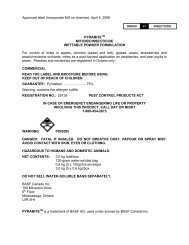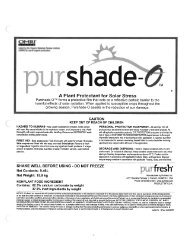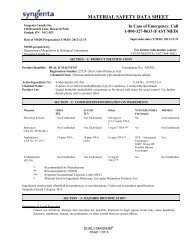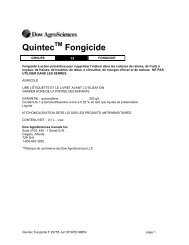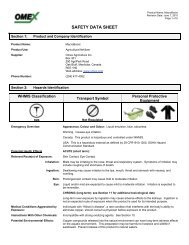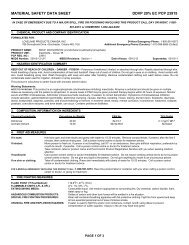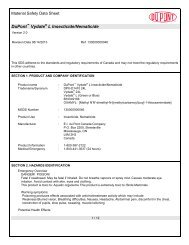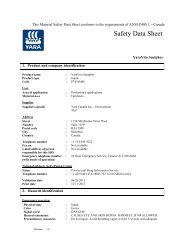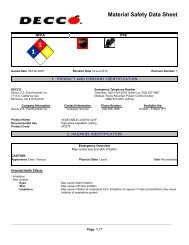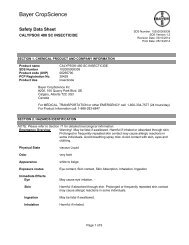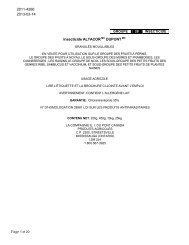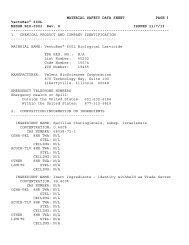Phosyn Hydromag 500 msds english.pdf - Bartlett.ca
Phosyn Hydromag 500 msds english.pdf - Bartlett.ca
Phosyn Hydromag 500 msds english.pdf - Bartlett.ca
Create successful ePaper yourself
Turn your PDF publications into a flip-book with our unique Google optimized e-Paper software.
YaraVita <strong>Hydromag</strong>Not suitable : None identified.Special exposure hazards : Promptly isolate the scene by removing all persons from the vicinity ofthe incident if there is a fire. No action shall be taken involving anypersonal risk or without suitable training.Hazardous thermaldecomposition productsSpecial protective equipmentfor fire-fightersSpecial remarks on firehazardsSpecial remarks on explosionhazards: Decomposition products may include the following materials:<strong>ca</strong>rbon dioxide<strong>ca</strong>rbon monoxidenitrogen oxidesmetal oxide/oxidesAvoid breathing dusts, vapors or fumes from burning materials.In <strong>ca</strong>se of inhalation of decomposition products in a fire, symptoms maybe delayed.ammonia: Fire-fighters should wear appropriate protective equipment and selfcontainedbreathing apparatus (SCBA) with a full face-piece operated inpositive pressure mode.: Non-flammable.: None.6. Accidental release measuresPersonal pre<strong>ca</strong>utions : No action shall be taken involving any personal risk or without suitabletraining. Evacuate surrounding areas. Keep unnecessary and unprotectedpersonnel from entering. Do not touch or walk through spilled material.Avoid breathing vapor or mist. Provide adequate ventilation. Wearappropriate respirator when ventilation is inadequate. Put on appropriatepersonal protective equipment (see Section 8).Environmental pre<strong>ca</strong>utions : Avoid dispersal of spilled material and runoff and contact with soil,waterways, drains and sewers. Inform the relevant authorities if theproduct has <strong>ca</strong>used environmental pollution (sewers, waterways, soil orair).Methods for cleaning upSmall spill : Stop leak if without risk. Move containers from spill area. Dilute withwater and mop up if water-soluble. Alternatively, or if water-insoluble,absorb with an inert dry material and place in an appropriate wastedisposal container. Dispose of via a licensed waste disposal contractor.Large spill : Stop leak if without risk. Move containers from spill area. Prevent entryinto sewers, water courses, basements or confined areas. Wash spillagesinto an effluent treatment plant or proceed as follows. Contain and collectspillage with non-combustible, absorbent material e.g. sand, earth,vermiculite or diatomaceous earth and place in container for disposalaccording to lo<strong>ca</strong>l regulations (see section 13). Dispose of via a licensedwaste disposal contractor. Note: see section 1 for emergency contactinformation and section 13 for waste disposal.7. Handling and storageHandling : Put on appropriate personal protective equipment (see Section 8). Eating,drinking and smoking should be prohibited in areas where this material ishandled, stored and processed. Workers should wash hands and facebefore eating, drinking and smoking. Remove contaminated clothing andprotective equipment before entering eating areas. Do not ingest. AvoidDate of issue : 06/26/2013Page:3/9
YaraVita <strong>Hydromag</strong>contact with eyes, skin and clothing. Avoid breathing vapor or mist.Keep in the original container or an approved alternative made from acompatible material, kept tightly closed when not in use. Emptycontainers retain product residue and <strong>ca</strong>n be hazardous. Do not reusecontainer. See also Section 8 for additional information on hygienemeasures.Storage : Store in accordance with lo<strong>ca</strong>l regulations. Store in original containerprotected from direct sunlight in a dry, cool and well-ventilated area,away from incompatible materials (see section 10) and food and drink.Keep container tightly closed and sealed until ready for use. Containersthat have been opened must be <strong>ca</strong>refully resealed and kept upright toprevent leakage. Do not store in unlabeled containers. Use appropriatecontainment to avoid environmental contamination.8. Exposure controls/personal protectionOccupational exposure limitsNo exposure standard allo<strong>ca</strong>ted.Consult lo<strong>ca</strong>l authorities for acceptable exposure limits.Engineering measures : No special ventilation requirements. Good general ventilation should besufficient to control worker exposure to airborne contaminants. If thisproduct contains ingredients with exposure limits, use processenclosures, lo<strong>ca</strong>l exhaust ventilation or other engineering controls to keepworker exposure below any recommended or statutory limits.Hygiene measures : Wash hands, forearms and face thoroughly after handling chemi<strong>ca</strong>lproducts, before eating, smoking and using the lavatory and at the end ofthe working period. Wash contaminated clothing before reusing. Awashing facility or water for eye and skin cleaning purposes should bepresent.Personal protectionRespiratory : Use a properly fitted, air-purifying or air-fed respirator complying withan approved standard if a risk assessment indi<strong>ca</strong>tes this is necessary.Respirator selection must be based on known or anticipated exposurelevels, the hazards of the product and the safe working limits of theselected respirator.Hands : Chemi<strong>ca</strong>l-resistant, impervious gloves complying with an approvedstandard should be worn at all times when handling chemi<strong>ca</strong>l products ifa risk assessment indi<strong>ca</strong>tes this is necessary.Eyes : Safety eyewear complying with an approved standard should be usedwhen a risk assessment indi<strong>ca</strong>tes this is necessary to avoid exposure toliquid splashes, mists or dusts. chemi<strong>ca</strong>l splash goggles.Skin : Personal protective equipment for the body should be selected based onthe task being performed and the risks involved and should be approvedby a specialist before handling this product.Environmental exposurecontrols9. Physi<strong>ca</strong>l and chemi<strong>ca</strong>l propertiesPhysi<strong>ca</strong>l state : liquid: Emissions from ventilation or work process equipment should bechecked to ensure they comply with the requirements of environmentalprotection legislation. In some <strong>ca</strong>ses, fume scrubbers, filters orengineering modifi<strong>ca</strong>tions to the process equipment will be necessary toreduce emissions to acceptable levels.Date of issue : 06/26/2013Page:4/9
YaraVita <strong>Hydromag</strong>Flash point : Not determined.Burning time : Not determined.Burning rate : Not determined.Auto-ignition temperature : Not determined.Flammable limits : Lower: Not determined.Upper: Not determined.Explosive properties : None.Oxidizing properties : None.Color : LightBrown.Odor : Not determined.pH : 9,8 [Conc.: 100 g/l]Boiling/condensation point : Not determined.Sublimation temperature : Not determined.Melting/freezing point : -7 °C (19 °F)Relative density : 1,511Vapor pressure : Not determined.Odor threshold : Not determined.Evaporation rate : Not determined.Viscosity : Dynamic: 1.<strong>500</strong> - 2.<strong>500</strong> mPa.s: Kinematic: Not determined.Solubility : Not determined.10. Stability and reactivityChemi<strong>ca</strong>l stability : The product is stable.Conditions to avoid : Avoid contamination by any source including metals, dust and organicmaterials.Incompatible materials : Urea reacts with <strong>ca</strong>lcium hypochlorite or sodium hypochlorite to formthe explosive nitrogen trichloride.Hazardous decomposition : Under normal conditions of storage and use, hazardous decompositionproductsPossibility of hazardousreactions11. Toxicologi<strong>ca</strong>l informationInformation on toxicologi<strong>ca</strong>l effectsAcute toxicityproducts should not be produced.: Under normal conditions of storage and use, hazardous reactions will notoccur.Product / Result Species Dose Exposure Referencesingredientname2-Propenoic acid, homopolymer, sodium saltLD50 Oral Rat > 40.000 mg/kg - PSTGAW20,16,1953Conclusion/Summary : No known signifi<strong>ca</strong>nt effects or criti<strong>ca</strong>l hazards.Chronic toxicityConclusion/Summary : No known signifi<strong>ca</strong>nt effects or criti<strong>ca</strong>l hazards.Irritation/CorrosionDate of issue : 06/26/2013Page:5/9
YaraVita <strong>Hydromag</strong>Product /ingredientname2-Propenoi<strong>ca</strong>cid,homopolymer,Result Species Score Exposure Observation ReferencesEyes - ModerateirritantRabbit -sodium saltConclusion/SummarySkin : No known signifi<strong>ca</strong>nt effects or criti<strong>ca</strong>l hazards.Eyes : May <strong>ca</strong>use eye irritation.Respiratory : No known signifi<strong>ca</strong>nt effects or criti<strong>ca</strong>l hazards.SensitizationConclusion/SummarySkin : No known signifi<strong>ca</strong>nt effects or criti<strong>ca</strong>l hazards.Respiratory : No known signifi<strong>ca</strong>nt effects or criti<strong>ca</strong>l hazards.CarcinogenicityConclusion/Summary : No known signifi<strong>ca</strong>nt effects or criti<strong>ca</strong>l hazards.MutagenicityConclusion/Summary : No known signifi<strong>ca</strong>nt effects or criti<strong>ca</strong>l hazards.TeratogenicityConclusion/Summary : No known signifi<strong>ca</strong>nt effects or criti<strong>ca</strong>l hazards.Reproductive toxicityConclusion/Summary : No known signifi<strong>ca</strong>nt effects or criti<strong>ca</strong>l hazards.IDLH : No data available.12.Ecologi<strong>ca</strong>l informationEcotoxicity : No known signifi<strong>ca</strong>nt effects or criti<strong>ca</strong>l hazards.Aquatic ecotoxicityProduct / ingredient Result Species Exposure Referencesname2-Propenoic acid, homopolymer, sodium saltAcute LC50 > 200 mg/l Fish - Fish. 96 hFresh waterConclusion/Summary : No known signifi<strong>ca</strong>nt effects or criti<strong>ca</strong>l hazards.Persistence/degradabilityConclusion/Summary : No known signifi<strong>ca</strong>nt effects or criti<strong>ca</strong>l hazards.Partition coefficient: n- : Not available.octanol/waterMobility : Not available.Other adverse effects : No known signifi<strong>ca</strong>nt effects or criti<strong>ca</strong>l hazards.13. Disposal considerationsProductMethods of disposal : The generation of waste should be avoided or minimized whereverpossible. Disposal of this product, solutions and any by-products shouldDate of issue : 06/26/2013Page:6/9
YaraVita <strong>Hydromag</strong>at all times comply with the requirements of environmental protectionand waste disposal legislation and any regional lo<strong>ca</strong>l authorityrequirements. Dispose of surplus and non-recyclable products via alicensed waste disposal contractor. Waste should not be disposed ofuntreated to the sewer unless fully compliant with the requirements of allauthorities with jurisdiction. Waste packaging should be recycled.Incineration or landfill should only be considered when recycling is notfeasible. This material and its container must be disposed of in a safeway. Care should be taken when handling emptied containers that havenot been cleaned or rinsed out. Empty containers or liners may retainsome product residues. Avoid dispersal of spilled material and runoff andcontact with soil, waterways, drains and sewers.Disposal should be in accordance with appli<strong>ca</strong>ble regional, national and lo<strong>ca</strong>l laws and regulations.Refer to Section 7: HANDLING AND STORAGE and Section 8: EXPOSURE CONTROLS/PERSONALPROTECTION for additional handling information and protection of employees.14.Transport informationRegulation: UN Class14.1 UN number Not regulated.14.2 UN proper shipping name14.3 Transport hazard class(es)14.4 Packing group14.5 Environmental hazards No.Additional information: UN ClassEnvironmental hazards : No.Regulation: IMDG14.1 UN number Not regulated.14.2 UN proper shipping name14.3 Transport hazard class(es)14.4 Packing group14.5 Environmental hazards No.14.6 Additional information : IMDGMarine pollutant: No.Regulation: IATA14.1 UN number Not regulated.14.2 UN proper shipping name14.3 Transport hazard class(es)14.4 Packing group14.5 Environmental hazards No.14.6 Additional information : IATAMarine pollutant: No.Regulation: DOT Classifi<strong>ca</strong>tion14.1 UN number Not regulated.14.2 UN proper shipping nameDate of issue : 06/26/2013Page:7/9
YaraVita <strong>Hydromag</strong>14.3 Transport hazard class(es)14.4 Packing group14.5 Environmental hazards No.14.6 Additional information : DOT Classifi<strong>ca</strong>tionEnvironmental hazards : No.Regulation: TDG Class14.1 UN number Not regulated.14.2 UN proper shipping name14.3 Transport hazard class(es)14.4 Packing group14.5 Environmental hazards No.14.6 Additional information : TDG ClassEnvironmental hazards : No.Special pre<strong>ca</strong>utions for user : Transport within user’s premises: always transport in closed containersthat are upright and secure. Ensure that persons transporting the productknow what to do in the event of an accident or spillage.’IMSBC : Not appli<strong>ca</strong>ble.Transport in bulk accordingto Annex II of MARPOL73/78 and the IBC Code: Not available.15.Regulatory informationCanadaWHMIS (Canada) : Class D-2B: Material <strong>ca</strong>using other toxic effects (Toxic).Canadian listsCanadian NPRI : None of the components are listed.CEPA Toxic substances : None of the components are listed.This product has been classified in accordance with the hazard criteria of the Controlled ProductsRegulations and the MSDS contains all the information required by the Controlled Products Regulations.Remark : To our knowledge no other country or state specific regulations areappli<strong>ca</strong>ble.International listsPhilippines inventory (PICCS): Not determined.New Zealand Inventory of Chemi<strong>ca</strong>ls (NZIoC): All components are listed or exempted.Korea inventory: Not determined.Japan inventory: Not determined.China inventory (IECSC): Not determined.Australia inventory (AICS): All components are listed or exempted.Canada inventory: Not determined.Malaysia Inventory (EHS Register): Not determined.Taiwan inventory (CSNN): Not determined.United States inventory (TSCA 8b): Not determined.EC INVENTORY (EINECS/ELINCS): All components are listed or exempted.Date of issue : 06/26/2013Page:8/9
YaraVita <strong>Hydromag</strong>16.Other informationLabel requirements : MAY CAUSE EYE IRRITATION.Key to abbreviations : ATE = Acute Toxicity EstimateBCF = Bioconcentration Factorbw = Body weightCEPA = Canadian Environmental Protection ActGHS = Globally Harmonized System of Classifi<strong>ca</strong>tion and Labelling of Chemi<strong>ca</strong>lsIDLH = Immediately Dangerous to Life or HealthIBC = Intermediate Bulk ContainerIMDG = International Maritime Dangerous GoodsLogPow = logarithm of the octanol/water partition coefficientMARPOL 73/78 = International Convention for the Prevention of Pollution FromShips, 1973 as modified by the Protocol of 1978. ("Marpol" = marine pollution)NPRI = National Pollutant Release InventoryUN = United NationsReferences : EU REACH IUCLID5 CSR.National Institute for Occupational Safety and Health, U.S. Dept. ofHealth, Edu<strong>ca</strong>tion, and Welfare, Reports and Memoranda Registry ofToxic Effects of Chemi<strong>ca</strong>l Substances.IHS, 4777 Levy Street, St Laurent, Quebec HAR 2P9, Canada.Date of printing : 12/11/2013Prepared by : Yara Product Classifi<strong>ca</strong>tions & Regulations.Date of issue : 06/26/2013Date of previous issue : 00/00/0000Version : 1.0|| Indi<strong>ca</strong>tes information that has changed from previously issued version.Notice to readerTo the best of our knowledge, the information contained herein is accurate. However, neither the abovenamedsupplier, nor any of its subsidiaries, assumes any liability whatsoever for the accuracy or completenessof the information contained herein. Final determination of suitability of any material is the soleresponsibility of the user. All materials may present unknown hazards and should be used with <strong>ca</strong>ution.Although certain hazards are described herein, we <strong>ca</strong>nnot guarantee that these are the only hazards thatexist.Date of issue : 06/26/2013Page:9/9



